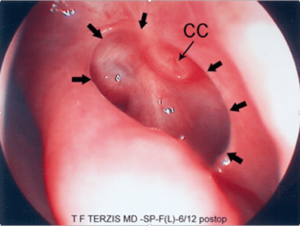Endoscopic treatment of the tearing eye (DCR)
The tears are continuously produced by a gland in the upper eyelid, and pool between the eyelids, to keep the eye moist and protect it from abrasions and irritations. Minute tubes in the eyelids collect excess tears and direct them to a sac hidden behind the nasal bones (lacrimal sac). From there, a wider tube named nasolacrimal duct drains the tears inside the nose, under the inferior turbinate. Inflammations, trauma or surgery can obstruct this sensitive drainage path from the eye to the nose. The eye tears continuously (epiphora), and sometimes the sac is infected, causing pain, swelling of the eye and purulent tears.

Endoscopic surgery offers a simple solution to the problem. With the help of the endoscopes, through the nose, the bone covering the lacrimal sac is removed and the interior of the sac is widely opened, draining freely the tears into the nasal cavity. The operation is called Dacryo-Cysto-Rhinostomy (DCR), is done under local or general anaesthesia, usually with the help of an Ophthalmologist-Occuloplastic Surgeon, and does not require hospitalization.
This website aims at providing simplified scientific information and not medical advice on specific conditions or individual cases. In this respect, it cannot replace the consultation and documented opinion of a specialist physician.
